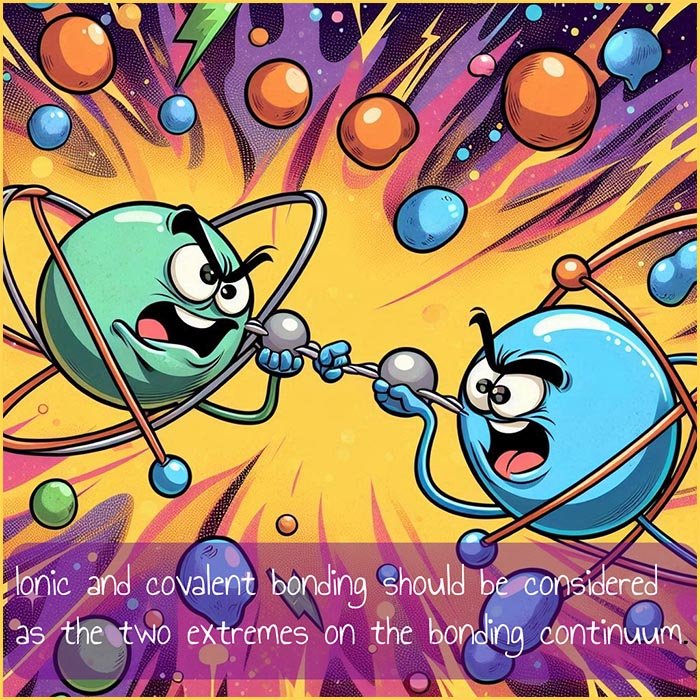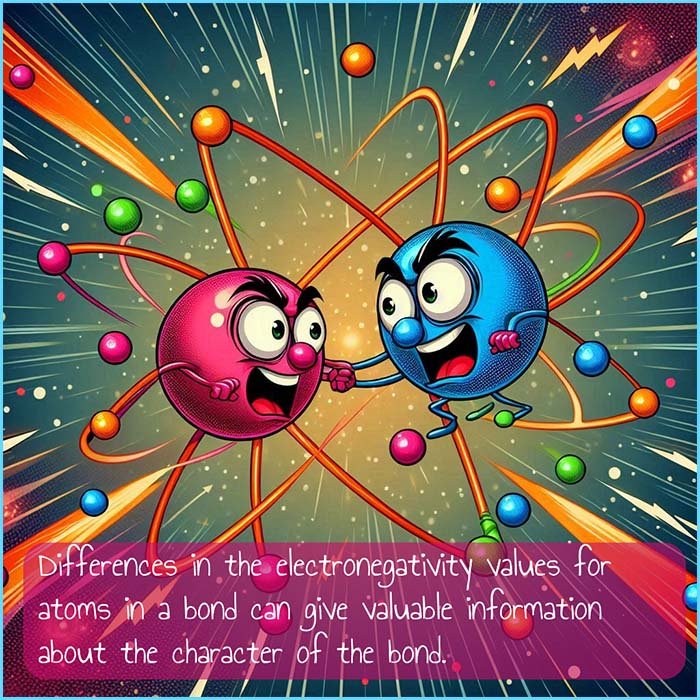

We can use the differences in the electronegativity values for elements to help determine the
character of a bond, that is to decide
whether the bond will be ionic, covalent or polar covalent.
The larger the difference in the electronegativity values between the two atoms in a bond the more
unequally the electrons in that particular bond will be shared. Recall that:

You will have probably heard the phrase that pure ionic and pure covalent are the two extremes in chemical bonding and that almost all chemical bonding that occurs in molecules is to be found somewhere on the bonding spectrum between these two extremes. This is where we can use the differences in the electronegativity values to predict the character of a bond.
| Difference in electronegativity | % ionic character in bond | % covalent character in bond |
|---|---|---|
| 0.1 | 0.5 | 99.5 |
| 0.3 | 2 | 98 |
| 0.5 | 5 | 95 |
| 0.7 | 11 | 89 |
| 0.9 | 20 | 80 |
| 1.1 | 25 | 75 |
| 1.3 | 35 | 65 |
| 1.5 | 43 | 57 |
| 1.7 | 50 | 50 |
| 1.9 | 60 | 40 |
| 2.1 | 68 | 32 |
| 2.3 | 75 | 25 |
| 2.5 | 80 | 20 |
| 2.7 | 85 | 15 |
| 2.9 | 89 | 11 |
| 3.1 | 92 | 8 |
We can use the differences in the electronegativity values from the table above to work out the percentage ionic/ covalent character in a bond. The table shows some simple calculations to work out the character for several common bonds found in many molecules.
| Bond and electronegativity value | Difference in electronegativity between the atoms | % ionic character/covalent character |
|---|---|---|
| C-H 2.55 2.20 |
0.35 | ~4% ionic/~96% covalent |
| C-O 2.55 3.44 |
0.89 | ~20% ionic/~80% covalent |
| N-H 3.04 2.20 |
0.84 | ~20% ionic/~80% covalent |
| Na-Cl 0.93 3.16 |
2.23 | ~68% ionic/~32% covalent |
| K-F 0.82 3.98 |
3.16 | ~92% ionic/~8% covalent |
From the table above you can see that bonds which we may always have considered as purely ionic such as Na-Cl do in fact have a
fairly large degree of covalent character in them and bonds such as N-H which we might assume
to be covalent have a
fairly large amount of ionic character in them.
However we can simplify the table above to give a more user friendly table. A general rule of thumb which can help provide a good basis for determining the character a particular bond is outlined in the table below:
| Ionic | Polar covalent | Covalent |
|---|---|---|
| Bonds between atoms with large differences in electronegativity of 1.9 or more will have ionic bonding between them. | Polar covalent bonds occur with differences in electronegativity values up to about 1.7, beyond which bonds tend to have more ionic character. | Non-polar covalent bonds typically occur when the electronegativity difference is less than 0.5. |
These rules should be used as a guide and not followed rigorously but they will help point us in the right direction as to the type of bonding present between atoms. As an example consider as an example the following three substances:
| Element | Na | H | F |
|---|---|---|---|
| Electronegativity | 0.93 | 2.20 | 3.98 |
| Compound | Difference in electronegativity | Bonding present |
|---|---|---|
| sodium fluoride | 3.98 - 0.93 = 3.05 | Ionic bonding. There is a very large difference in the electronegativity (3.05), well above the threshold of 1.9 for ionic bonding. |
| hydrogen fluoride | 3.98 - 2.20 = 1.78 | Polar covalent bonding present. The electrons in the H-F bond will be mostly located towards the fluorine atom due to its large electronegativity value |
| fluorine | 3.98 - 3.98 = 0 | No difference in electronegativity so bonding will be covalent |
